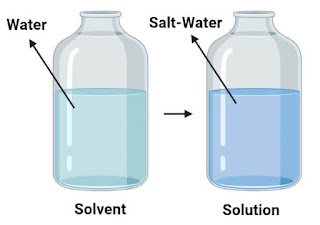What is a Solvent, Type of Solvent & uses of solvent
A solvent is the component of a solution that is present in the greatest amount. It is the substance in which the solute is dissolved. Usually, a solvent is a liquid. However, it can be a gas, solid, or supercritical fluid. The amount of solvent required to dissolve a solute depends on temperature and the presence of other substances in a sample. The word "solvent" comes from the Latin solvō, which means to loosen or untie.
What is a Solvent?
A solvent is a molecule that has the ability to dissolve other molecules, known as solutes. A solvent can be solid, liquid or gas. The molecules of the solvent work to put the solute molecules apart. Eventually, the molecules of solute become evenly distributed in throughout the solvent. This homogenous mixture is perfectly even, and cannot be separated physically. Heat or another chemical process must be applied to the solution to separate the solvent and solute.
Types of Solvent:
1. Polar Solvents
Polar solvents work through the actions of the positive and negative ends of each atom interacting with each other, and the solute. A polar solvent dissolves a solute by the electrical charges pulling on different parts of the solute molecules. Polar solvents can dissolve ionic compounds, like salt, by pulling on the oppositely charged molecules. The negative side of solvent molecules pull on the positive ions in the compound. The positive side of other solvent molecules pull on the negative ions. In this way the ions become evenly distributed throughout the solvent.
2. Nonpolar Solvents
Nonpolar solvents work in a similar way to polar solvents. Nonpolar molecules that act as solvents are usually spontaneous dipoles, in that they occasionally form opposite electrical charges between bonds. These momentary electrical dipoles cause nearby solvent molecules to also form dipoles. These fleeting interactions can dissolve other nonpolar compounds. However, polar compounds typically have stronger interactions between each other than with the momentary dipoles of nonpolar molecules. This is why nonpolar and polar solvents, like water and oil, do not mix.
3. Aprotic Solvents
Aprotic solvents do not release protons , but may act either as a simple solvent , where polarity as measured by the dielectric constant is significant , or they may act as a proton acceptor i.e. aprotic basic. Aprotic solvents are polar compounds of liquid that contain no dissociable atoms of hydrogen. Chemical bodies such as O-H and N-H bonds are absent from these solvents. Therefore, hydroxyl groups (-OH) and amine groups (-NH2) are absent from aprotic solvents and are unable to form hydrogen bonds.
Aprotic solvents share with protic solvents the ability of ion dissolving. There is a lack of acidic hydrogen in these protic solvents, thus no major release of hydrogen ions. Polar aprotic solvents have dielectric constant values that are minimal or moderate. A moderate polarity is seen by these solvents.
4. Protic Solvents
A protic solvent is made up of molecules that may serve as donors of hydrogen-bonds. Examples of protic solvents contain water, alcohol, and carboxylic acids. Solvents that are unable to serve as donors to hydrogen-bonds are considered aprotic solvents. Examples of aprotic solvents include ether, methylene chloride and hexane.
Compounds that can be described by the general formula ROH are polar protic solvents. The polarity of the polar protic solvents occurs from the O-H bond bond dipole. Combined with the small size of the hydrogen atom, the large difference in the electronegativity of the oxygen and the hydrogen atom warrants the isolation of molecules comprising the OH group from those polar compounds which do not.
Uses Of Solvent
The uses of solvents may be the following:
Paints and coatings.
Inks.
Personal care products such as cosmetics, nail remover.
Cleaning products.
Healthcare applications such as pharmaceutical products.
Automobiles in washer fluid to remove dirt and grime from the windshield.
Solvent Examples
common examples of solvents include water, ethanol, methanol and acetone. The term ‘solvent’ can be defined as a substance that has the ability to dissolve a given solute to form a solution with it. Although solvents are mostly used in the liquid state, it is possible for solvents to exist in the solid and gaseous phase as well. Some common examples of solvents are listed below.
Water
Ethanol
Methanol
Acetone
Tetrachloroethylene
Toluene
Methyl acetate
Ethyl acetate
Hexane
Benzene

Comments
Post a Comment